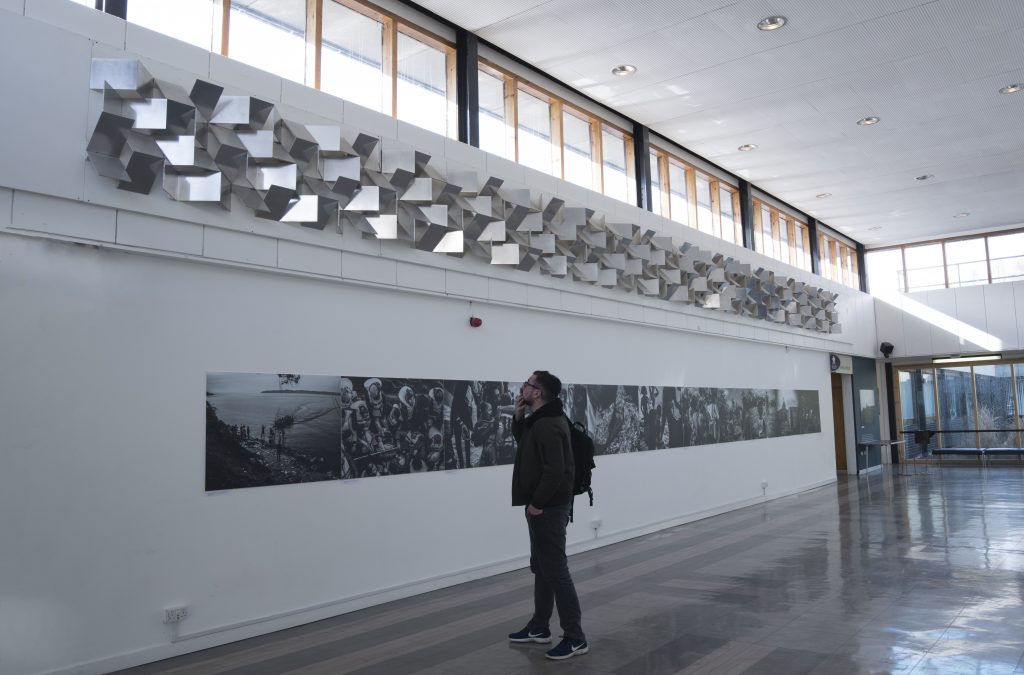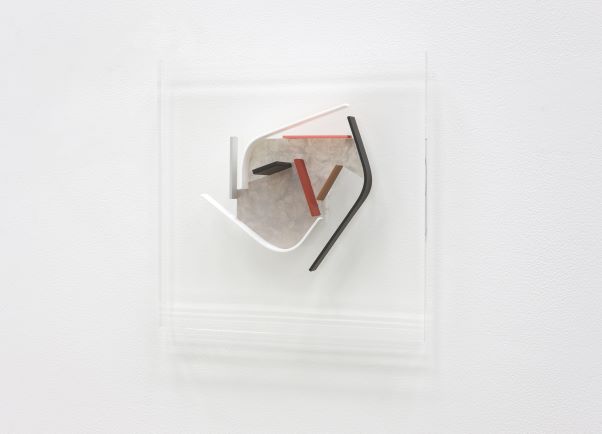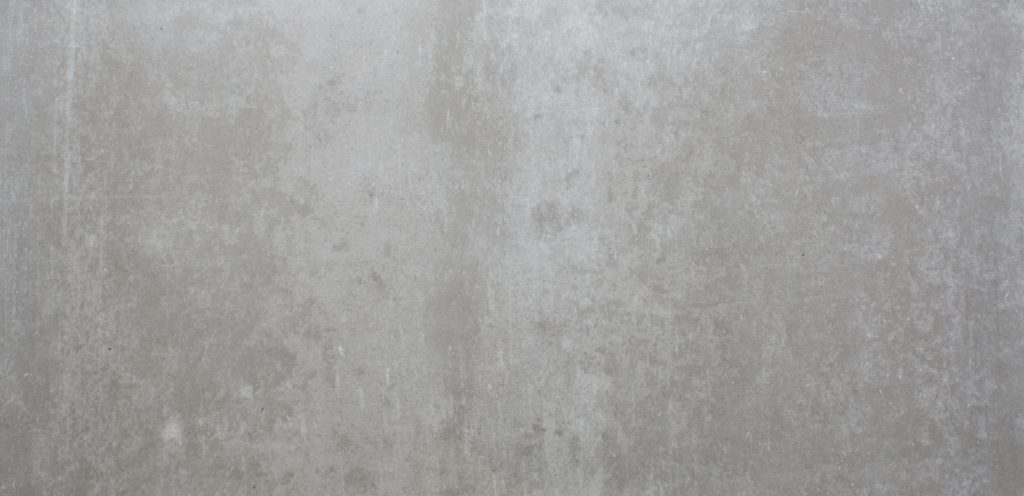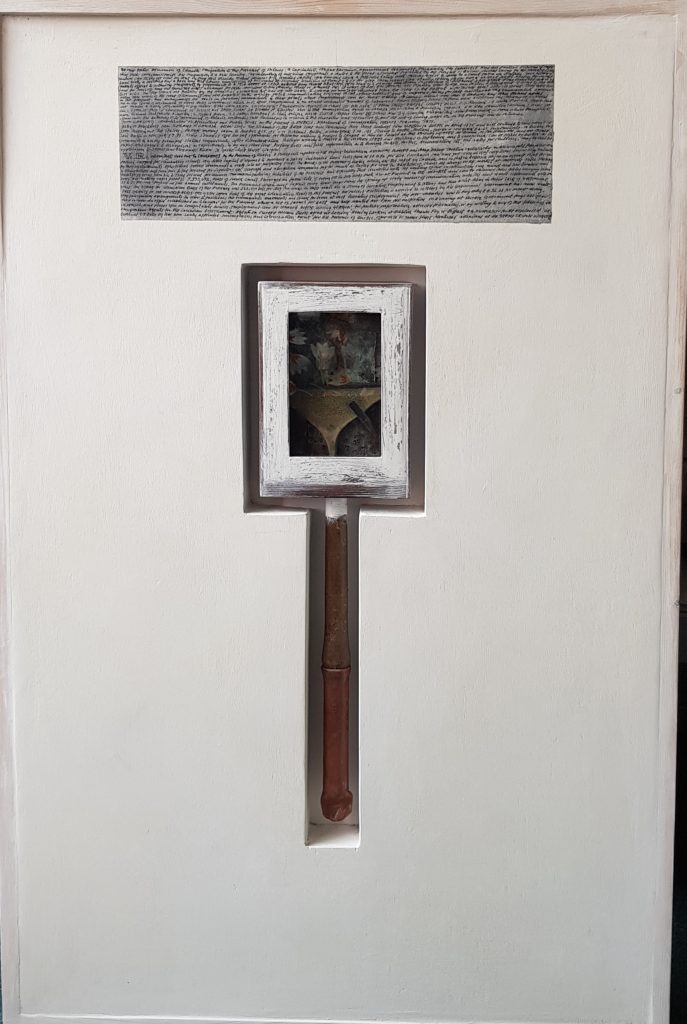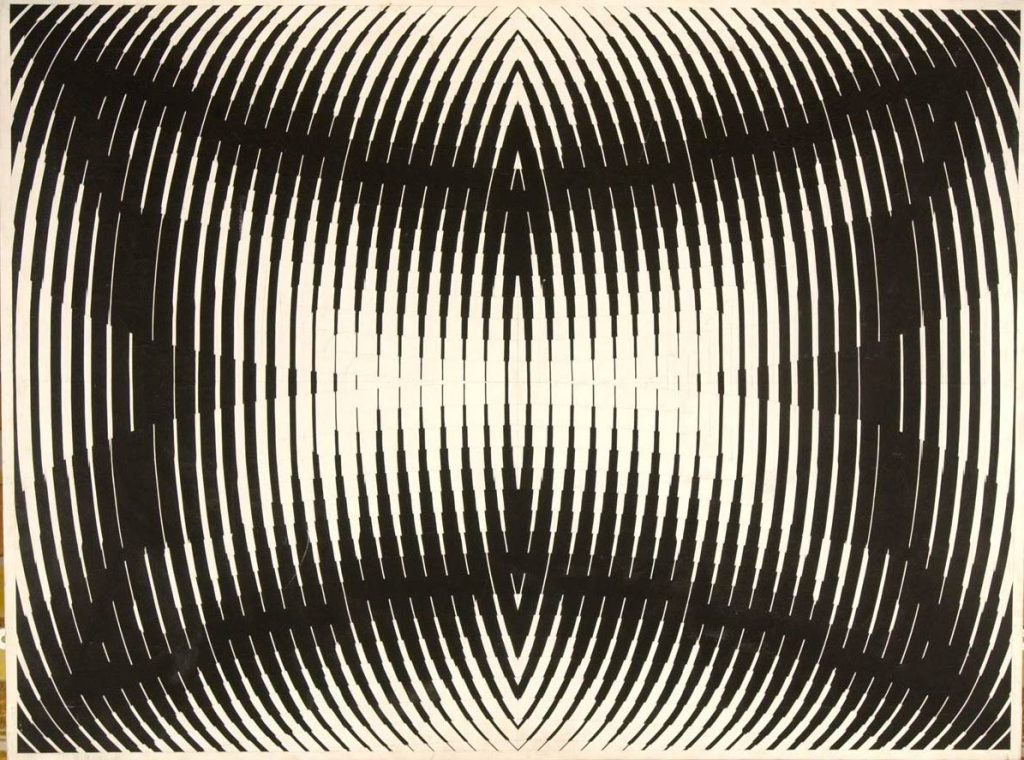A selection of works from the permanent collection.

For the new academic year 2022/3 the Art Collection has installed a series of exhibitions in the Pathfoot Building under the umbrella theme ‘Space & Place’. In the Crush Hall you will find an exhibition of works from the University’s permanent collection, selected to fit with this year’s theme. Here we focus on some of these works.
The remarkable ‘Wall Construction’ or ‘Mural’ commissioned specifically for the Pathfoot Building in the late 1960s is of course a permanent feature in the Crush Hall. The artist Mary Martin (1907-1969) was one of a small group dubbed the Constructionists in the 1950s (alongside her husband Kenneth Martin, Victor Pasmore and Anthony Hill), whose focus was the use of naturally-occurring proportional systems and rhythms underpinning their geometrical art. They were directly inspired by the ‘constructive’ art produced in the 1930s by artists such as Barbara Hepworth, and the Russian constructivism movement which preceded them, and they were passionate about creating art for the public, which would be visible and play a role in the modern post-war architecture of the times, for instance in the new towns of the 50s and 60s.
In this way, the choice of Mary Martin was extremely apposite for this location, and the resulting work greatly compliments the Pathfoot Building. The original plan was for Martin to create more works: just as Pathfoot was described as the ‘parent cell’ of the University, so this work was seen as the first of a potential series of works throughout the developing campus – but in fact it turned out to be the artist’s last public commission and she sadly died before it was installed. Moving on from previous works of the early 1960s, in which Martin employed solid cubes sliced diagonally through at 45 degrees, she here expands on an idea used in her work ‘Inversions’ (1966 – now in the Tate) which replaces the solidity of the cubes with polished aluminium ‘floating’ diagonal planes (see top image). These introduce a lightness and modularity, where movement is implied both in a system of positive and negative spaces, and also in the play of light over mirrored surfaces. It is further reflected in the design of the Pathfoot Building itself, making the work feel very much part of its environment. For more on this work, click here.
Also currently on show in the Crush Hall is the ‘maquette’ or preliminary model of this work, alongside three newly purchased works by Toby Paterson.
Toby Paterson (1974-) is a Glasgow-based artist whose paintings, reliefs, and sculptural installations reflect on the visual experience offered over time by the art and architecture of post-war Britain. This can clearly be observed in the three pieces of work newly acquired by the Art Collection (purchase supported by the National Fund for Acquisitions – all currently on display). And indeed on a recent visit to the University, Toby told us that as a student in the early 90s he recalls visiting a friend at Stirling, and seeing the Wall Construction (above) in its original location in the Pathfoot dining room. There is a pleasing symmetry to this story – without even knowing at the time that this was a work by Mary Martin, he later went on to be influenced by her, and now his own work is here, occupying the same space as the Mural that he first saw so long ago. In another similarity with Martin, Toby is currently working on two further site-specific pieces to hang in Pathfoot.
Mainly concerned with cities and modernist architecture, Paterson is influenced by both his physical experience of a place (often on skateboarding journeys) and his interest in its history, asking ‘what cultural, political and economic situation had made that place exist?’ His work encourages the viewer to consider their perception of the built environment, architecture and the city. Another skateboarding artist in the collection is Robbie Hamilton.
Robbie works with utilitarian, raw materials. Years of skateboarding have made him appreciate materials from the urban environment such as concrete, which he either frames as it is, as with this piece, or paints with standard emulsion paint. In his work he draws our attention to these working materials which he feels ‘are important and shouldn’t be overlooked’.
Bronwen Sleigh is another artist in the collection inspired by the built environment and architecture. This work is based on a place in Eastern Canada visited by the artist on a research trip. She says ‘I was interested in finding man-made structures in very remote parts of Canada. Manic Cinq is a dam.’
A very different interpretation of a sense of place in the world, comes in the form of the work of Will Maclean. In his art, ‘Maclean gives a voice, or more accurately, voices to a range of communities which did not have a voice or whose voices were subjugated by powerful hegemonic interests of profit or control; they could be crofters cleared from the land, people stripped of their language, or people tied to industries such as fishing or whaling which are now residual in a society driven by the demands of late Capitalism’. Lindsay Blair. The artist writes: ‘The history of the emigration from Highland Scotland has been a subject that I have returned to in my work as an artist. This work was prompted by the text from the advertisement pages of the Gaelic magazine ‘An Gaaidheal’ published in Glasgow in 1872. It has living family connections, in the 1880s, when members of my father’s family left the over-crowded crofts of Coigach to search for fame and fortune in the silver mine towns of Nevada and the diamond mine towns of South Africa. These Gaelic speakers brought with them their uncompromising form of Calvinism and this is reflected in the central image of the church-offering box’.
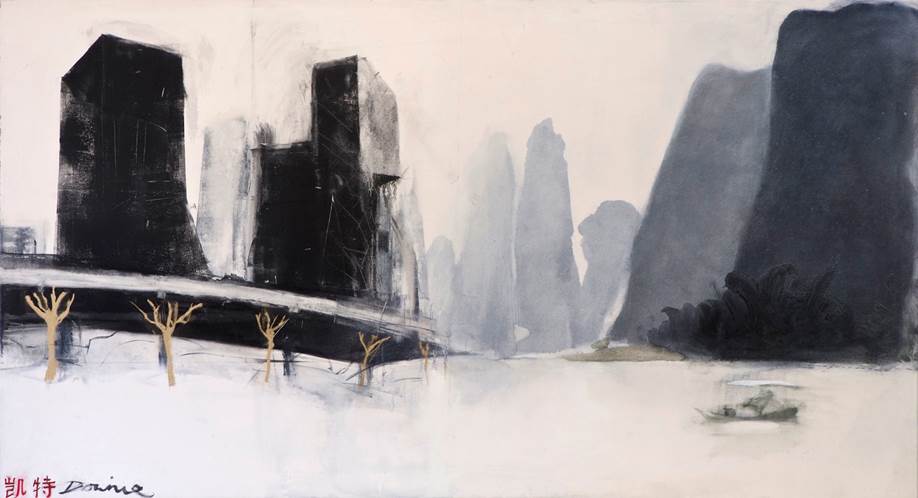
Kate Downie (1958-)
During a series of visits to China, between 2010 and 2013, Scottish artist, Kate Downie, was brought into contact with traditional ink painting techniques, but also with the China of today. There she encountered the contrasts and meeting points between the epic industrial and epic romantic landscapes: the motorways, rivers, cityscapes and geology – all of which she has absorbed and reflected on in a series of oil and ink paintings. As Downie creates studies for her paintings in situ, she is very much immersed in the landscapes that she is responding to and reflecting on.
This piece, NanBei, tackles similar themes to Downie‘s Scottish-based work, reflecting both her interest in the urban landscape and also the edges where land meets water. Here we encounter both aspects within a new setting – an industrial Chinese landscape set by the edge of a vast river. Downie is also obsessed with bridges. As well as the bridge that appears in this image, seemingly supported by trees that follow its line, the space depicted forms an unseen bridge between two worlds and two extremes, between epic natural and epic industrial forms. In this imagined landscape north meets south and mountains meet skyscrapers; here both natural and industrial structures dominate the landscape. This juxtaposition is one of the aspects of China that impressed the artist and inspired the resulting works.
Finally, to return to abstraction, Jeffrey Steele’s work in the 1960s was two-dimensional and two-tonal, and explored the idea of space and how we conceive space. He explained his work as ‘visual black and white impressions based upon a series of lines of length which increase in mathematical progression’. He was interested not only in the creation of a sense of space within artworks, but was also interested in how an audience responds to art and the way in which they move in the space around an artwork in order to gain different perspectives.
